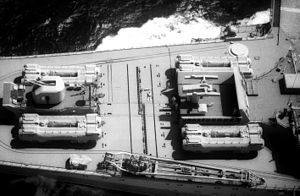P-500 Bazalt
| P-500 Bazalt / P-1000 Vulkan (NATO reporting name: SS-N-12 'Sandbox') |
|
|---|---|

Eight SS-N-12 launchers on the aircraft carrier Kiev
|
|
| Type | Sub- or surface-to-surface missile |
| Place of origin | Soviet Union |
| Service history | |
| In service | Since 1975 |
| Used by | Soviet Union, Russia |
| Production history | |
| Designer | OKB-52/NPO Mashinostroyeniya Chelomey |
| Designed | 1963-1974 |
| Manufacturer | P.A. Strela |
| Produced |
1970–1987 (P-500) 1985–1992 (P-1000) |
| Specifications | |
| Weight | 4,800 kg (10,600 lb) |
| Length | 11.7 meter |
| Diameter | 0.88 meter |
| Warhead | High-explosive or nuclear |
| Warhead weight | 1,000 kg (2,205 lb) (P-500) |
| Blast yield | 350 kt |
|
|
|
| Engine | turbojet |
| Wingspan | 2.6 meter |
|
Operational
range |
550 km (300 nmi) (P-500) |
| Flight altitude | 50-5.000 meter |
| Speed | Mach 2.5 |
|
Guidance
system |
Semi-active radar homing, terminal active radar homing |
| Accuracy | 300-700 meter |
|
Launch
platform |
Echo II & Juliett submarines Kiev & Slava class ships |
1970–1987 (P-500)
The P-500 Bazalt (Russian: П-500 «Базальт»; English: basalt) is a turbojet-powered, supersonic cruise missile used by the Soviet and Russian navies. Its GRAU designation is 4K80 and its NATO reporting name is SS-N-12 Sandbox, modern version is P-1000 Vulkan AShM SLCM.
Developed by OKB-52 MAP (later NPO Mashinostroyeniye), it entered service to replace the SS-N-3 Shaddock. The P-500 Bazalt was first deployed in 1975 on the Soviet aircraft carrier Kiev, and was later added to both the Echo II class submarine and the Juliett class submarine. A version of the P-500 Bazalt with improved guidance and engines is used on the Slava class cruiser. The sixteen launchers dominate the decks of the class.
The P-500 Bazalt has a 550 km range and a payload of 1,000 kg, which allows it to carry a 350 kt nuclear or a 950 kg semi-armor-piercing high-explosive warhead. The P-500 Bazalt uses active radar homing for terminal guidance, and can receive mid-course correction from the Tupolev Tu-95RTs Bear D, the Kamov Ka-25K Hormone B and the Kamov Ka-31.
The missiles were intended to be used in salvos; a submarine could launch eight in rapid succession, maintaining control of each through a separate datalink. In flight the group could co-ordinate their actions; one would fly to a higher altitude and use its active radar to search for targets, forwarding this data to the other missiles which remained at low altitude. The missiles were programmed so that half of a salvo would head for a carrier target, with the rest dividing between other ships. If the high-flying missile was shot down, another from the salvo would automatically pop up to take its place. All of the missiles would switch to active radar for the terminal phase of the attack.
...
Wikipedia
